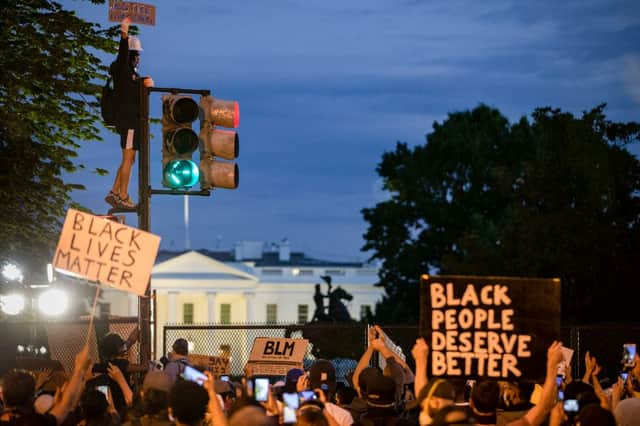Here's what the Black Lives Matter movement represents - and why it's offensive to say All Lives Matter


George Floyd a 46-year-old black man died in Minneapolis when a policeman knelt on his neck for over eight minutes, despite the victim’s cries of “I can’t breathe”.
Footage of the incident has sparked protests across the United States and the globe, with demonstrators saying that this was another example of black people being targeted by authorities because of their race.
Advertisement
Hide AdAdvertisement
Hide AdProtestors have stood off with police since the incident on May 25, chanting “I can’t breathe”, “don’t shoot”, and “Black Lives Matter”.
What is the #BlackLivesMatter movement?
The #BlackLivesMatter movement was founded in 2013 following the acquittal of George Zimmerman.
Zimmerman was accused of murdering Trayvon Martin, a 17-year-old African American boy. Zimmerman had called the police telling them that Martin was behaving “suspicious” before confronting him and shooting him after a struggle. Zimmerman claimed that he was acting in self-defence.
Black Lives Matter campaigns against violence and systemic racism aimed at black people through protests and digital activism.
Advertisement
Hide AdAdvertisement
Hide AdIn their own words the movement was founded with the aim of eradicating white supremacy and building “local power to intervene in violence inflicted on Black communities by the state and vigilantes”.
The movement was founded by black community organisers Alicia Garza, Patrisse Cullors, and Opal Tometi, though they have highlighted the need for locally led movements rather than national leadership
#BlackLivesMatter gained momentum and support as a movement following the deaths of Eric Garner in New York and Michael Brown in Ferguson, Missouri in 2014.
#BlackLivesMatter cites the civil rights movement, the Black Power movement, the 1980s Black feminist movement, Pan-Africanism, the Anti-Apartheid Movement, LGBTQ social movements, and Occupy Wall Street as inspiration for their activism.
What does Black Lives Matter mean?
Advertisement
Hide AdAdvertisement
Hide AdThe term Black Lives Matter can now be used in reference to the movement, the slogan, twitter hashtag and assemblage of groups campaigning for racial equality.
Critics of the slogan have described it as exclusionary, however Columbia Law Professor Kimberle Crenshaw explained that the term Black Lives Matter as “aspirational”.
Writing for Harpers Bazaar in 2019 Rachel Elizabeth Cargle said that Black Lives Matter is “a rallying cry for a shift in statistical numbers that show that people who are black are twice as likely to be killed by a police officer while unarmed, compared to a white individual.”
Why saying All Lives Matter is wrong
Opposition of Black Lives Matter have taken to responding by saying “All Lives Matter”.
Advertisement
Hide AdAdvertisement
Hide AdUse of All Lives Matter downplays the disproportionate racism and police brutality experienced by black people.
Keeanga-Yamahtta Taylor of Princeton University told the New York Times that the idea that All Lives Matter has always been an assumption.
He adds: “The entire point of Black Lives Matter is to illustrate the extent to which black lives have not mattered in this country”.
Cargle used an analogy to highlight the issue of saying All Lives Matter.
Advertisement
Hide AdAdvertisement
Hide AdShe wrote: “If a patient being rushed to the ER after an accident were to point to their mangled leg and say, “This is what matters right now,” and the doctor saw the scrapes and bruises of other areas and countered, “but all of you matters,” wouldn’t there be a question as to why he doesn't show urgency in aiding that what is most at risk?”
What is the meaning of the clenched fist symbol?
Protestors holding up closed fists has been a regular sight at #BlackLivesMatter demonstrations and protests in recent days.
The clenched fist has a long history, originally used by marginalised groups worldwide experiencing oppression. It’s viewed as a rejection of unjust authority and a show of resistance.
When the Black Panther Party was founded in 1966 by Huey P. Newton and Bobby Seale to challenge police brutality against the African American community, the black power fist was repeatedly used as a symbol of black liberation.
Advertisement
Hide AdAdvertisement
Hide AdThe black power salute was famously used by American sprinters Tommie Smith and John Carlos at the 1968 Mexico City Olympics Games who both received medals. Donning black gloves they raised their fists while the national anthem played during the medal ceremony.
Anti-apartheid activist Nelson Mandela raised a fist in triumph when he was released from prison in 1990.
The clenched fist was adopted by #BlackLivesMatter following the death of Michael Brown in Ferguson, Missouri in August 2014.
White police shot the unarmed black teenager dead by, with witnesses alleging that Brown had raised his hands before being shot. The black power fist was then used to represent the "hands up, don't shoot" pose.